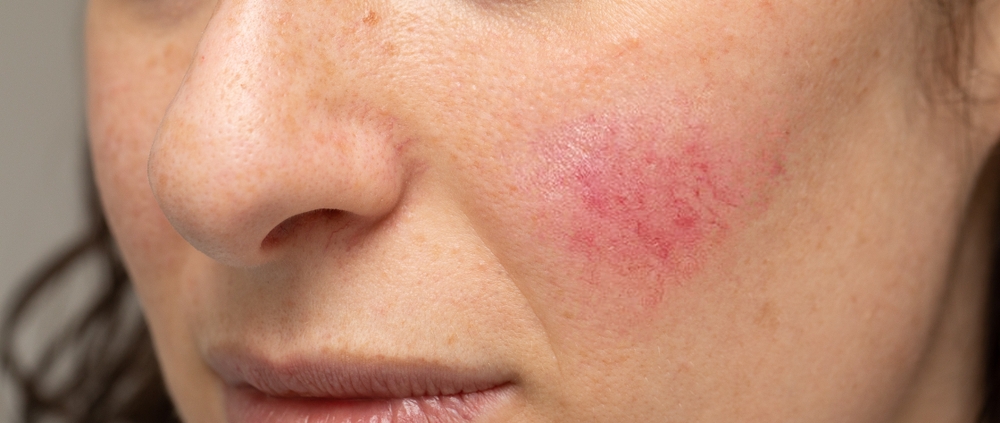PHYT’S Decongesting and Soothing Cream for Skin Redness
All skin types can be prone to diffuse redness which usually manifest itself by small pink patches on cheeks (rosy cheeks), nose and chin – very often with visible micro-capillaries.
There is a network of delicate veins, under the skin of the face, responsible for blood circulation – they are called capillaries. These very thin vessels are fragile and can be damaged easily. Diffuse redness appears when the capillaries walls weaken and get damaged. Normally capillaries dilate when there is a rush of blood to the skin, then contract afterwards. Damaged capillaries do not contract – and can also break – resulting in blood stagnation within these vessels. When this happens, the capillaries become more visible and look like tiny red lines under the skin. The thinner your skin, the more noticeable the capillaries will be.
Diffuse redness can occur for several reasons: heredity, environment, sun exposure, menopause, alcohol, medical conditions, stress. Ageing is also a cause of broken capillaries as the skin becomes thinner and more sensitive.
It is important to remember that this kind of skin redness is not a skin type but a skin condition. Broken capillaries are difficult to erase, so it’s important to try to prevent the weakening of the walls of the capillaries to avoid their excess dilation or breakage.
Phyt’s Capyl Cream to reinforce capillaries walls
Capyl is a localised treatment cream that has been specially formulated to decongest capillaries and reinforce their walls – it is not a moisturiser, so its use should be followed by the application of a moisturiser.
Phyt’s Laboratories developed the Capyl formula with plant-based ingredients well known for their decongesting and toning properties. We will have a closer look at three of them:
- Centella Asiatica
- Red Vine
- Horse Chestnut
Centella Asiatica
Centella asiatica, also known as Gotu Kola or Indian pennywort, is a herb that’s been traditionally used in Indian Ayurvedic medicine.
One of the first known skin benefits of Centella Asiatica was its ability to promote wound healing. In fact, this is one of the plants most widely studied benefits, with a large number of both in vitro and in vivo scientific studies supporting the claim. It appears that the wound healing properties of Centella Asiatica extracts are largely due to the increased production of collagen and the reduction in inflammation.
The research into the wound-healing benefits of Centella Asiatica also identified its effectiveness at boosting collagen production, particularly type I collagen. As the production of collagen and the amount of collagen within the skin decreases with age, this research suggests that Centella Asiatica may have anti-ageing effects.
Red Vine (Grape Vine)
Who does not know the red vine? It is a climbing, woody plant belonging to the Vitaceae family. Its grape is famous around the world for its main purpose: the production of red wine. On the health side, you should know that red vine is particularly beneficial to support a healthy blood circulation.
The skin, leaves and seeds are used in various herbal medicine preparations and skincare ingredients to balance venous insufficiency, water retention and cardiovascular diseases.
Grape Vine or Red Vine is packed with antioxidants like flavonoid, resveratrol, polyphenols and tannin, which help fight ageing by restoring collagen and elastin fibers.
Horse Chestnut
Horse Chestnut extract is derived from the seeds of the Horse Chestnut tree (Aesculus Hippocastanum). Horse chestnut is native to areas of Europe, but is now grown in many places around the world. Historically, horse chestnut has been used for purposes as diverse as a whitening agent for fabrics and as a soap. More recently, it has been found to be of benefit in disorders of the venous system, particularly chronic venous insufficiency.
Aescin (also spelt escin) is the most abundant active compound of horse chestnut extract. It carries a powerful antioxidant called Proanthocyanidins which has a role in the stabilisation of collagen and elastin in the skin, and acts as an anti-ageing compound. Aescin is also a powerful anti-inflammatory ingredient, and helps reduce capillaries fragility to prevent those thin vessels breaking and leaking fluids in the surrounding tissues.
Important: it must be noted that Capyl Cream is not a treatment for Rosacea which looks like couperose but is a skin disorder that needs different kinds of treatments.
If you have signs of diffuse redness (no matter your skin type), the best thing to do is to look after your skin with a daily skin care routine that includes:
- Gentle skin cleansing with a cleanser that does not rip off all oil from your skin. Do not use overly hot or cold water. If you use a skin toner, make sure it does not contain alcohol (over-drying)
- Capyl Cream applied on the red areas only, then followed with the application of a moisturiser. Do this morning and evening.
- A skin corrector to hide the redness. Use a green corrector and apply it to the red areas only. Green being the complementary colour of red, it will neutralise that colour. Follow with a foundation and finish with loose powder for a mat finish that will last all day.






